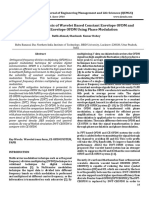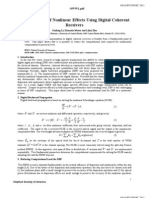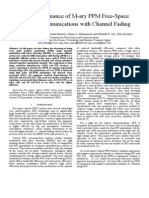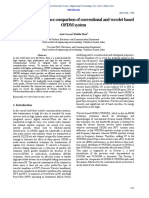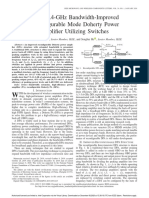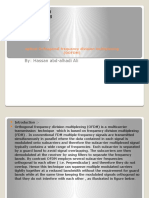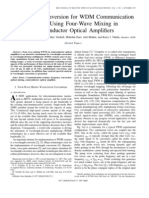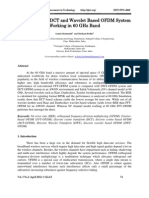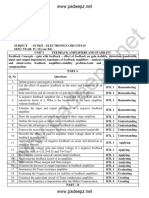Behavioral Variations of Gain and NF Owing to
Behavioral Variations of Gain and NF Owing to
Uploaded by
Lydia BOUCHOUCHACopyright:
Available Formats
Behavioral Variations of Gain and NF Owing to
Behavioral Variations of Gain and NF Owing to
Uploaded by
Lydia BOUCHOUCHACopyright
Available Formats
Share this document
Did you find this document useful?
Is this content inappropriate?
Copyright:
Available Formats
Behavioral Variations of Gain and NF Owing to
Behavioral Variations of Gain and NF Owing to
Uploaded by
Lydia BOUCHOUCHACopyright:
Available Formats
Optics and Photonics Journal, 2012, 2, 8-12
http://dx.doi.org/10.4236/opj.2012.21002 Published Online March 2012 (http://www.SciRP.org/journal/opj)
Behavioral Variations of Gain and NF Owing to
Configurations and Pumping Powers
Belloui Bouzid
Hafr Al-Batin Community College (HBCC), King Fahd University of Petroleum and Minerals (KFUPM), Dhahran, Saudi Arabia
Email: Bouzid@hbcc.edu.sa
Received November 29, 2011; revised January 5, 2012; accepted January 12, 2012
ABSTRACT
Six configurations are proposed in this paper to explore the gain and noise figure (NF) variations under the pumping
power effect. I propose a new investigation of gain and NF at different EDFA configurations. Configurations such as
SPSS, DPSS, DPSSF, TPDS, TPDSF, and QPDSF are designed, investigated and compared. A continuous progress of
gain values is observed from SPSS to QPDSF, and a change of NF values related to configurations is recorded. The NF
variations show different behaviors at different configurations. High gain of 59.49 dB and low NF value of 4.22 dB are
recorded for the QPDSF configuration and low gain and low NF are recorded for the SPSS configuration.
Keywords: Double Pass; Single Pass; Erbium Doped Fiber; Configuration; Pumping Power
1. Introduction milestone role in this crucial era.
The lack of entire description of behavioral study of
EDFA is a crucial milestone in optical communication
gain and NF at different configurations in the published
systems and wide growing internet. The progressive de-
papers will affect the fast growing of optical amplifier
velopment of EDFA since its early stage at the end of
and reduce its effectiveness. Most of the published pa-
eightieth is showing a continuous progress at the two
pers are focusing on NF and efficiency [1], gain and gain
levels of EDFA knowledge, theoretical and experimental. flattening [2-5], and optimization of pumping power [6]
EDFA is an important part in the long haul optical fiber without any research papers which, focuses on the de-
communication, and it is considered as another interesting scription of the complete behavioral variations and trends
research topic for laser phenomena of spontaneous and of EDFA gain and NF at different configurations.
stimulated emission, where interaction of matter-light- All factors affecting the EDFA are needed to be elabo-
matter still in its early stage. rated and investigated to enhance the amplification out-
Fiber to the home will guide the future changes of puts. Focusing on improvement of gain and noise figure,
communication in the near future. Laser with the stimu- the devised and optimized configuration is to establish a
lated and spontaneous emission are considered to be the wide and flat EDFA gain [2-5], and to discover an effi-
main factor in the next quantum revolution. Let us think cient EDFA at all levels. The obligation for an efficient
how terabits transmission can be carried out without fiber EDFA is to fulfill the practical need of communication,
optics or fiber amplifier? How the narrow band of elec- with high capacity and high speed.
tronics can be handling the wide broad band of commu- The EDFA description at different configurations is
nication systems? At the beneath of the laser phenomena rarely found in the published papers [7], and the use of
there are many promising future development and new the entire physical phenomena to describe, illustrate, and
discoveries that can be conditionally achieved. Optical interpret the variations of gain and NF at different con-
amplifier and lasers are used nearly in all the wide spec- figurations is highly required to understand their trends at
trum of science such as medicine, military, education and large-scale.
manufacturing. In this paper general descriptions with illustrations and
Research in optical communication systems is growing analysis are performed based on the studies of six differ-
daily. In addition, the obligation for efficient systems to ent configurations: single pass single stage (SPSS), dou-
fulfill the practical need of communication for high ca- ble pass single stage (DPSS), double pass single stage
pacity and high speed is extremely demanded due to the with filter (DPSSF), triple pass double stage (TPDS),
fast growing of high speed and high capacity transmis- triple pass double stage with filter (TPDSF) and quadru-
sion. Highly efficient and stable EDFAs is playing a ple pass double stage with filter (QPDSF) [8].
Copyright © 2012 SciRes. OPJ
B. BOUZID 9
2. Experiment Setup and Discussion of power, and the wavelength division multiplexer (WDM)
Results is to merge both 980 nm pump and 1550 nm signal in
The used erbium-doped fiber in this experiment is char- EDF. The signal will be reacted with stimulated emission
acterized by: NA of 0.27 cutoff wavelength of 840 nm, and amplified spontaneous emission (ASE) where at the
peak absorption at the signal 1527 nm wavelength of 6 output the ASE and the stimulated signal will be dis-
dB/m, erbium concentration of 440 ppm, and Er3+ core played. The filter will eliminate almost all ASE; the OSA
doped in silica/germania. The New port, tunable band displays the amplified signal with small portion of ASE
pass filter (TBF) is mechanically tuned with a pass-band at the bottom of the signal.
of 1 nm, an insertion loss of 1.5 dB at the tuned wave- The six configurations were shown in Figure 1(a)
length, and a tuning range limited to 45 nm from 1520 to SPSS: single pass single stage, Figure 1(b) DPSS: dou- ble
1565 nm. The Tunable Laser Source (TLS) is a continu- pass single stage, Figure 1(c) DPSSF: double pass single
ous wavelength source of the 1550 nm input signal stage with filter, Figure 1(d) TPDS: triple pass double
Figure 1. Experimental configurations of EDFA: (a) single pass single stage (SPSS); (b) double pass single stage (DPSS); (c)
double pass single stage with filter (DPSSF); (d) triple pass double stage (TPDS); (e) triple pass double stage with filter
(TPDSF) and (f) quadruple pass double stage with filter (QPDSF). TBF: tunable bandpass filter, CIR: circulator, EDF:
erbium-doped Fiber, LD: laser diode, and WDM: wavelength division multiplexing, INPUT: tunable laser source, and
OUTPUT: optical spectrum analyzer.
Copyright © 2012 SciRes. OPJ
10 B. BOUZID
stage, Figure 1(d) TPDSF: triple pass double stage with at the changing of configurations from SPSS, DPSS,
filter, and QPDSF: quadruple pass double stage with fil- DPSSF, TPDSF and QPDSF. Except for the TPDS with-
ter. The difference between these configurations is owing out filter, which shows a lower gain compared to DPSSF
to the additions of TBF and the second stage which can and TPDSF.
be single pass or double pass. The circulators are used as It can be seen clearly, by following the variations of
loop back where port1 and 3 are spliced and the TBF is gain values versus configurations, at lower pump power
incorporated between these ports to suppress and elimi- of 10 mW, the gain is varied at different configurations
nate the unwanted ASE. The Key role of TBF in this where a shift between 9.65 and 45 dB of the gain values
continuous increase of gain is impressive and crucial is recorded for SPSS and QPDSF respectively. At higher
where stimulated emission will strongly amplify the signal. pumping power of 90 mW the gain is shifted owing to
Due the large number of configurations used in these configurations change from 20.04 to 59.49 dB. All these
experiments, we will describe only the signal in the results are at 1550 nm input signal power and –50 dBm
QPDSF configuration. The configuration in Figure 1(f) except the SPSS. This good result shows clearly the var-
showed that each turn consistently gave a signal attenua- ied configurations, the filter, and the double pass impact
tion of 12 dB, this loss is due to three circulators, two on the gain values. So, with the change of configuration
TBF filters, and two WDMs. Thus, the amplified signal from SPSS to QPDSF, the gain is increased to 45 dB at
will propagate through the CIR1 from port1 to port2 then low pumping power. The gain gap between the SPSS and
travel through EDF1; the signal will be affected by the QPDSF reach to 39.45 dB at high pump power.
first amplification from EDF1, through port2 into port3 Go in details for the shown results in the figure. The
of CIR2, passing through the first TBF1 filter into port1 SPSS records the lowest gain where the QPDSF records
and back to port2 to be amplified during the second pass the highest one. At this level of explanation, the effect of
by EDF1 into port2 of CIR1, and therefore will propa- the configurations type is very crucial where the gain gap
gate again in the second stage through EDF2, CIR3, and between the SPSS and QPDSF reach approximately
TBF2 for the third and fourth passes. The output signal 35.83 dB at 10 mW pump power. It is evident that the
power was displayed through the OSA from port4 of effect of the pumping power and configuration with filter
CIR1. Traveling from port1 to port4 of CIR1, the signal are effective for the gain enhancement. It is also observed,
will be affected by four amplifications during the four that the DPSSF has a higher gain compared with TPDS
passes, or, as we mentioned, the quadruple pass double where single stage has higher gain compared to double
stage with filter configuration [8]. stage. I think, the role of filter in the design is certainly
Figure 2 shows gain on dB versus configurations and crucial and principal in this reversed phenomenon. In this
pumping power. The input signal power is at 1550 nm case it is recorded that adding single stage single pass to
wavelength and –50 dBm only the SPSS. From the 3D the double pass configuration will reduce the gain.
graph, all the six configurations show an increase of gain Figure 3 shows experimental NF versus configura-
Figure 2. Experimental gain versus configurations and pumping power at 1550 nm wavelength at –50 dBm input signal
power. SPSS: single pass single stage, DPSS: double pass single stage, DPSSF: double pass single stage with filter, TPDS:
triple pass double stage, TPDSF: triple pass double stage with filter, and QPDSF: quadruple pass double stage with filter.
Copyright © 2012 SciRes. OPJ
B. BOUZID 11
Figure 3. Experimental NF versus configurations and pumping power at 1550 nm wavelength at −50 dBm input signal power.
SPSS: single pass single stage, DPSS: double pass single stage, DPSSF: double pass single stage with filter, TPDS: triple pass
double stage, TPDSF: triple pass double stage with filter, and QPDSF: quadruple pass double stage with filter.
Table 1. Gain and NF variations due to configuration. shown in this paper, that the configuration structure and
the filter are crucial in the variation of the gain and NF.
Configurations Gain NF
In particular, high gain can be generated simply with
SPSS LOW LOWEST simple modification related to the design structure.
QPDSF records 59.49 dB gain and 4.22 dB NF. This
DPSS LOW HIGH
result can be increased higher with fifth or sixth passes
DPSSF HIGH LOW and higher pump power. Table 1 shows the description
TPDS LOW HIGH and the comparison of gain and NF at different configu-
rations.
TPDSF HIGH HIGH
QPDSF HIGHEST LOW 3. Conclusion
The configurations SPSS, DPSS, DPSSF, TPDS, TPDSF,
tions and pumping power at input signal power of 1550 and QPDSF were exposed to the same conditions of input
nm wavelengths and −50 dBm except SPSS. It is evident signal power wavelength and different pumping power.
that the NF is decreased at specific configurations and The full investigation of gain and NF shows high gain of
increased at others. The 3D graph shows clearly that the 59.49 dB and low NF of 4.22 dB values of QPDSF con-
NF is decreased at three configurations. It is also evident figuration. Gain and NF were profoundly described and
that the NF is bellow 5 dB for the SPSS, DPSSF, and clearly investigated using both 3D and 2D graphs display.
QPDSF configurations, and above 5 dB for the DPSS, A continuous increasing of gain values was demonstrated.
TPDS, and TPDSF configurations. The TPDS and TPDSF The gain progress was recorded from SPSS, DPSS,
show the highest NF compared with the other configura- DPSSF, TPDS, TPDSF, to QPDSF configurations. A
tions. variation of NF related to different configurations was
It can be noted the effect of adding the single pass
proved and demonstrated. The TBF positioned in the
stage to the double pass on increasing of noise figure. In
between the circulator ports, configurations structure, and
the double stage double pass the TBF filter is affecting
pumping power are a principal factors for gain and NF
the QPDSF and the DPSSF and enhance their NF. The
control.
configuration SPSS records the lowest NF with the low-
est gain, QPDSF records the highest gain. This can be
4. Acknowledgments
related to the multi factors that have been included such
as: double pass, double stage, and the filter positioned The author wishes to acknowledge UPM, MMU (Malay-
between the two ports of the circulator. It is clearly sia) and HBCC/KFUPM (Saudi Arabia) for their support
Copyright © 2012 SciRes. OPJ
12 B. BOUZID
in providing the various facilities utilized in the presenta- Tellurite Fiber Amplifier for WDM Signals in the 1581 -
tion of this paper. 1616 nm Wavelength Region,” Electronics Letters, Vol.
36, No. 36, 2000, pp. 621-622.
[5] C. Yang, “Design and Simulation of Gain-Flattened Ultra
REFERENCES Wideband Fiber Amplifiers Covering S-, C-, and L-
[1] A. C. Çokrak and A. Altuncu, “Gain and Noise Figure bands,” Ph. D Thesis, The University of North Carolina at
Performance of Erbium-Doped Fiber Amplifiers,” Jour- Charlotte, Charlotte, 2003.
nal of Electrical & Electronics Engineering, Vol. 4, No. 2, [6] M. A. Mahdi, K. A. Khairi, B. Bouzid and M. K. Abdul-
2004, pp. 1111-1122. lah “Optimum Pumping Scheme of Dual-Stage Triple-
[2] B. Bouzid, B. M. Ali and M. K. Abdullah. “A High Gain Pass Erbium-Doped Fiber Amplifier,” IEEE Photonics
EDFA Design Using Double Pass Amplification with a Technology Letters, Vol. 16, No. 2, 2004, p. 419.
Band-Pass Filter,” Photonics Technology Letters, Vol. 15, doi:10.1109/LPT.2003.821059
No. 9, 2003, pp. 1195-1197. [7] A. Sellami, K. Al-Khateeb and B. Belloui, “The Influence
doi:10.1109/LPT.2003.814901 of EDFA’s Configuration on the Behavioral Trends of
[3] Y. B. Lu and P. L. Chu, “Gain Flattening by Using Dual- Gain,” International Conference on Computer and Man-
Core Fiber in Erbium-Doped Fiber Amplifier,” IEEE agement, Kuala Lumpur, 9-11 May 2006, pp. 853-856.
Photonics Technology Letters, Vol. 12, No. 12, 2000, pp. [8] B. Bouzid, “High-Gain and Low-Noise-Figure Erbium-
1616-1617 . Doped Fiber Amplifier Employing Dual Stage Quadruple
[4] A. Mori, T. Sakamoto, K. Shikano, K. Kobayashi, K. Pass Technique,” Optical Review, Vol. 17, No. 3, 2010,
Hoshino and M. Shimizu, “Gain Flattened Er3+-Doped pp. 100-102.
Copyright © 2012 SciRes. OPJ
You might also like
- Es2c0 Lab Assessment PDFDocument28 pagesEs2c0 Lab Assessment PDFdinski desNo ratings yet
- Some Studies On Gain Spectra Optimization of Multi Pumped Th3+ - Er3+ (Thulium Erbium) Doped Hybrid Optical AmplifierDocument8 pagesSome Studies On Gain Spectra Optimization of Multi Pumped Th3+ - Er3+ (Thulium Erbium) Doped Hybrid Optical AmplifierInternational Journal of Engineering and TechniquesNo ratings yet
- Recent Advances of Distributed Optical Fiber Raman Amplifiers in Ultra Wide Wavelength Division Multiplexing Telecommunication NetworksDocument11 pagesRecent Advances of Distributed Optical Fiber Raman Amplifiers in Ultra Wide Wavelength Division Multiplexing Telecommunication NetworksMr. RAVI KUMAR INo ratings yet
- ABER Performance of LDPC Coded OFDM FSOC System Over Exponential Weibull Fading Channel-2017Document14 pagesABER Performance of LDPC Coded OFDM FSOC System Over Exponential Weibull Fading Channel-2017r.a.patel5No ratings yet
- Analysis The Utility & Comparative Study of Reduction Techniques of Peak-to-Average Power Ratio (PAPR) in OFDM System & Its Performance AnalysisDocument8 pagesAnalysis The Utility & Comparative Study of Reduction Techniques of Peak-to-Average Power Ratio (PAPR) in OFDM System & Its Performance Analysisamber agarwalNo ratings yet
- Overview of EDFA For The Efficient Performance Analysis: Anuja Dhokar, S.D.DeshmukhDocument8 pagesOverview of EDFA For The Efficient Performance Analysis: Anuja Dhokar, S.D.DeshmukhIOSRJEN : hard copy, certificates, Call for Papers 2013, publishing of journalNo ratings yet
- Comparative Analysis of Wavelet Based Constant Envelope OFDM and Constant Envelope OFDM Using Phase ModulationDocument5 pagesComparative Analysis of Wavelet Based Constant Envelope OFDM and Constant Envelope OFDM Using Phase ModulationIjemls IjemlsNo ratings yet
- Four-Wave Mixing in Photonic Crystal Fibres For Wavelength Conversion in Optical NetworksDocument4 pagesFour-Wave Mixing in Photonic Crystal Fibres For Wavelength Conversion in Optical NetworksDrSneha SharmaNo ratings yet
- Coh 1Document2 pagesCoh 1chunnumunnuNo ratings yet
- EDFADocument43 pagesEDFAMuhammad Bilal Iqbal100% (2)
- M BCJR FinalDocument5 pagesM BCJR FinalBui Van ThanhNo ratings yet
- Hu 2017Document4 pagesHu 2017bto7500No ratings yet
- High Performance Efficiency of Distributed Optical Fiber Raman Amplifiers For Different Pumping Configurations in Different Fiber Cable SchemesDocument21 pagesHigh Performance Efficiency of Distributed Optical Fiber Raman Amplifiers For Different Pumping Configurations in Different Fiber Cable SchemesijcsnNo ratings yet
- BER Performance of M-Ary PPM Free-Space Optical Communications With Channel FadingDocument5 pagesBER Performance of M-Ary PPM Free-Space Optical Communications With Channel Fadingfardeen123No ratings yet
- Influence of Bidirectional Pumping in High-Power EDFA On Single-Channel, Multichannel and PulsedDocument7 pagesInfluence of Bidirectional Pumping in High-Power EDFA On Single-Channel, Multichannel and Pulsedmuyucel3No ratings yet
- Compatible TDM/WDM PON Using A Single Tunable Optical Filter For Both Downstream Wavelength Selection and Upstream Wavelength GenerationDocument3 pagesCompatible TDM/WDM PON Using A Single Tunable Optical Filter For Both Downstream Wavelength Selection and Upstream Wavelength Generationumer2013emc15No ratings yet
- Optimization of LDMOS TransistorDocument84 pagesOptimization of LDMOS TransistorLuís PaisNo ratings yet
- Oel 2016 0304Document4 pagesOel 2016 0304onesimomanuel7No ratings yet
- Adaptive Bias Layered Optical OFDM Based On Precoding For IM-DD SystemsDocument7 pagesAdaptive Bias Layered Optical OFDM Based On Precoding For IM-DD SystemsJúlio Fernandes de OliveiraNo ratings yet
- Design and Performance Analysis of Dynamic EDFA: Anuja Dhokar, S.D.DeshmukhDocument11 pagesDesign and Performance Analysis of Dynamic EDFA: Anuja Dhokar, S.D.DeshmukhIOSRJEN : hard copy, certificates, Call for Papers 2013, publishing of journalNo ratings yet
- Design of 1-18 GHZ Parabolic Re Ector Antenna With Lpda FeedDocument4 pagesDesign of 1-18 GHZ Parabolic Re Ector Antenna With Lpda FeedAugusto RadaelliNo ratings yet
- Theoretical Calibration of Dual-Pumps Fiber Optical Parametric AmplifierDocument7 pagesTheoretical Calibration of Dual-Pumps Fiber Optical Parametric AmplifierInternational Journal of Application or Innovation in Engineering & ManagementNo ratings yet
- Weighted Cyclic Prefix OFDM: PAPR Analysis and Performances Comparison With DFT-PrecodingDocument7 pagesWeighted Cyclic Prefix OFDM: PAPR Analysis and Performances Comparison With DFT-PrecodingSurya Bhaskar KommuguriNo ratings yet
- Diffraction-Limited, 10-W, 5-ns, 100-kHz, All-Fiber Laser at 1.55 MDocument5 pagesDiffraction-Limited, 10-W, 5-ns, 100-kHz, All-Fiber Laser at 1.55 MBengüsu GüvenNo ratings yet
- A Radio-On-Hybrid WDM Transport System Based On Mutually Injection-Locked FP LdsDocument4 pagesA Radio-On-Hybrid WDM Transport System Based On Mutually Injection-Locked FP LdslalitdeadgoalsNo ratings yet
- 40 Gb:s DWDM Structure With Optical Phase Configuration For Long-Haul Transmission SystemDocument8 pages40 Gb:s DWDM Structure With Optical Phase Configuration For Long-Haul Transmission SystemRicardo ChangNo ratings yet
- 2022-TED-Novel Step Field Plate RF LDMOS Transistor For Improved BV textDS - R textON Tradeoff and RF Performance PDFDocument7 pages2022-TED-Novel Step Field Plate RF LDMOS Transistor For Improved BV textDS - R textON Tradeoff and RF Performance PDFXiaole JiaNo ratings yet
- 1-s2.0-S0030399219302312-mainDocument6 pages1-s2.0-S0030399219302312-mainr74h7zfrbcNo ratings yet
- Continuously Wavelength-Tunable Laser Source Using A Self-Injected FabryProt Laser DiodeDocument3 pagesContinuously Wavelength-Tunable Laser Source Using A Self-Injected FabryProt Laser Diodecy yNo ratings yet
- GOYANI - A Review - Performance Comparison of Conventional and Wavelet Based OFDM SystemDocument4 pagesGOYANI - A Review - Performance Comparison of Conventional and Wavelet Based OFDM SystemAnonymous PsEz5kGVaeNo ratings yet
- Lab 1Document5 pagesLab 1Kemei NixonNo ratings yet
- Fiber Optical Parametric Amplifiers in Optical Communication SystemsDocument25 pagesFiber Optical Parametric Amplifiers in Optical Communication SystemsHaojia SUNNo ratings yet
- A 1.8-3.4-Ghz Bandwidth-Improved Reconfigurable Mode Doherty Power Amplifier Utilizing SwitchesDocument4 pagesA 1.8-3.4-Ghz Bandwidth-Improved Reconfigurable Mode Doherty Power Amplifier Utilizing Switchestejendra kumarNo ratings yet
- A Weighted OFDM Signal Scheme For Peak-to-Average Power Ratio Reduction of OFDM SignalsDocument4 pagesA Weighted OFDM Signal Scheme For Peak-to-Average Power Ratio Reduction of OFDM Signalsjagadeesh jagadeNo ratings yet
- A Multiquantum-Dot-Doped Fiber Amplifier With Characteristics of Broadband, Flat Gain, and Low NoiseDocument7 pagesA Multiquantum-Dot-Doped Fiber Amplifier With Characteristics of Broadband, Flat Gain, and Low NoiseJitesh VermaNo ratings yet
- Lab 1Document4 pagesLab 1Kemei NixonNo ratings yet
- Optical Orthogonal Frequency Division MultiplexingDocument11 pagesOptical Orthogonal Frequency Division MultiplexingFloraDasNo ratings yet
- A Review On PAPR Reduction Technique in OFDMDocument4 pagesA Review On PAPR Reduction Technique in OFDMzelalemaschaleyNo ratings yet
- PH.D 12thesis BUR 24 09 16 Final25 PDFDocument191 pagesPH.D 12thesis BUR 24 09 16 Final25 PDFAshok patelNo ratings yet
- WDM 4waveDocument10 pagesWDM 4waveLam Tran VietNo ratings yet
- Optimization of Four Wave Mixing Effect in Radio-Over-Fiber For A 32-Channel 40-GBPS DWDM SystemDocument6 pagesOptimization of Four Wave Mixing Effect in Radio-Over-Fiber For A 32-Channel 40-GBPS DWDM SystemLương Xuân Dẫn100% (1)
- Broadband Optical Frequency Comb Generation With Flexible Frequency Spacing and Center WavelengthDocument8 pagesBroadband Optical Frequency Comb Generation With Flexible Frequency Spacing and Center Wavelengthazzaali0909No ratings yet
- An Overview of Peak-To-Average Power Ratio Reduction Techniques For Ofdm SignalsDocument20 pagesAn Overview of Peak-To-Average Power Ratio Reduction Techniques For Ofdm SignalsLawrence AveryNo ratings yet
- Dispersion Compensation in Optical Communication Link Using Apf'SDocument4 pagesDispersion Compensation in Optical Communication Link Using Apf'SAnonymous WUImtJNo ratings yet
- Narrow Spacing Dual-Wavelength Fiber Laser Based On Polarization Dependent Loss ControlDocument7 pagesNarrow Spacing Dual-Wavelength Fiber Laser Based On Polarization Dependent Loss ControlMahedi HasanNo ratings yet
- Analysis of Research Articles: BouchouchayosraDocument42 pagesAnalysis of Research Articles: Bouchouchayosraيسرى بوشوشةNo ratings yet
- High-PSR CMOS LDO With Embedded Ripple Feedforward and Energy-Efficient Bandwidth ExtensionDocument6 pagesHigh-PSR CMOS LDO With Embedded Ripple Feedforward and Energy-Efficient Bandwidth ExtensionMitchell LeeNo ratings yet
- 1-Gb/s Transmission Over A Phosphorescent White LED by Using Rate-Adaptive Discrete Multitone ModulationDocument10 pages1-Gb/s Transmission Over A Phosphorescent White LED by Using Rate-Adaptive Discrete Multitone ModulationSyed Fawad AdilNo ratings yet
- Iterative Receiver For Flip-OFDM in Optical Wireless CommunicationDocument6 pagesIterative Receiver For Flip-OFDM in Optical Wireless CommunicationShravan KumarNo ratings yet
- Comparison of DCT and Wavelet Based Ofdm System Working in 60 GHZ BandDocument10 pagesComparison of DCT and Wavelet Based Ofdm System Working in 60 GHZ Bandsachin10dulkarNo ratings yet
- Materi DWDMDocument273 pagesMateri DWDMFiqriHidayatNo ratings yet
- Multilevel Modulations For Gigabit Access in A Simple Millimeter-Wave Radio-Over-Fiber LinkDocument4 pagesMultilevel Modulations For Gigabit Access in A Simple Millimeter-Wave Radio-Over-Fiber LinkchandanNo ratings yet
- Peak To Average Power Ratio Reduction in Nc-Ofdm Systems: Saadia Tabassum - Sajjad Hussain - Abdul GhafoorDocument5 pagesPeak To Average Power Ratio Reduction in Nc-Ofdm Systems: Saadia Tabassum - Sajjad Hussain - Abdul GhafoorAbdiaziz RashidiNo ratings yet
- Radio Over Fiber Technology Using Electro-Absorption ModulationDocument9 pagesRadio Over Fiber Technology Using Electro-Absorption ModulationMuneeb Raees MalikNo ratings yet
- Symposium On Personal, Indoor, and Mobile Radio Communications (PIMRC 2018) (Pp. 73-79) - Institute of Electrical and Electronics EngineersDocument8 pagesSymposium On Personal, Indoor, and Mobile Radio Communications (PIMRC 2018) (Pp. 73-79) - Institute of Electrical and Electronics EngineerssurendranathNo ratings yet
- Impact of Polarization Interleaving (PI) On WDM-FSO System: Neha Gupta, Dr. Amandeep Singh SappalDocument4 pagesImpact of Polarization Interleaving (PI) On WDM-FSO System: Neha Gupta, Dr. Amandeep Singh SappalerpublicationNo ratings yet
- PAPR Reduction Techniques in OFDM SystemDocument7 pagesPAPR Reduction Techniques in OFDM SystemEighthSenseGroupNo ratings yet
- Design and Performance Analysis of EDFADocument6 pagesDesign and Performance Analysis of EDFADaoud ElalouanyNo ratings yet
- Wideband RF Technologies and Antennas in Microwave FrequenciesFrom EverandWideband RF Technologies and Antennas in Microwave FrequenciesNo ratings yet
- Radio Propagation and Adaptive Antennas for Wireless Communication Networks: Terrestrial, Atmospheric, and IonosphericFrom EverandRadio Propagation and Adaptive Antennas for Wireless Communication Networks: Terrestrial, Atmospheric, and IonosphericNo ratings yet
- AE2022-2023 - Project Report (Abbas Ismail-Raed Awa - 230719 - 135653Document39 pagesAE2022-2023 - Project Report (Abbas Ismail-Raed Awa - 230719 - 135653hung kungNo ratings yet
- Audio Calculator 1.73Document9 pagesAudio Calculator 1.73GUINo ratings yet
- Applied Electronics II (Chapter 2)Document29 pagesApplied Electronics II (Chapter 2)Ermias Mesfin100% (2)
- AH102ADocument5 pagesAH102AashfaqNo ratings yet
- Study On Shure SM57 and Neumann TLM102Document11 pagesStudy On Shure SM57 and Neumann TLM102leoNo ratings yet
- MC 1496Document12 pagesMC 1496Alejandro GarciaNo ratings yet
- lm334 PDFDocument12 pageslm334 PDFnguyen daoNo ratings yet
- (Bernstein 2003) Introducing Signals, Systems and Control in Grades K Through 12Document3 pages(Bernstein 2003) Introducing Signals, Systems and Control in Grades K Through 12Kai Boonloon GohNo ratings yet
- Modeling of Electrical and Mechanical Systems: Lectures 12-15Document87 pagesModeling of Electrical and Mechanical Systems: Lectures 12-15blzz2netNo ratings yet
- GRM Tools Evolution - EngDocument26 pagesGRM Tools Evolution - Engvincent216No ratings yet
- CH 2 - Op-Amp ApplicationDocument52 pagesCH 2 - Op-Amp Applicationknighthood4all100% (3)
- Pspice Simulation of Mosfet Amplifier Configurations: 2.1 ObjectiveDocument8 pagesPspice Simulation of Mosfet Amplifier Configurations: 2.1 ObjectivePreet PatelNo ratings yet
- First Watt F1 Service ManualDocument14 pagesFirst Watt F1 Service ManualasenmtNo ratings yet
- S-AV36 DatasheetDocument4 pagesS-AV36 Datasheetpaprati7965No ratings yet
- Final Examination Control SystemsDocument32 pagesFinal Examination Control SystemsJohn Manuel BautistaNo ratings yet
- Fundamental of EEG MeasurementDocument12 pagesFundamental of EEG MeasurementRyna Aulia Falamy100% (1)
- Pulsar-23 Utilities Manual ENDocument8 pagesPulsar-23 Utilities Manual ENfuckoff1234561No ratings yet
- Operational AmplifierDocument112 pagesOperational AmplifierEdson TorresNo ratings yet
- pb717x Users ManualDocument12 pagespb717x Users ManualMiquéias LiraNo ratings yet
- Laboratory ExercisesDocument28 pagesLaboratory ExerciseskibweantNo ratings yet
- MC33201, MC33202, MC33204, NCV33202, NCV33204 Low Voltage, Rail To Rail Operational AmplifiersDocument16 pagesMC33201, MC33202, MC33204, NCV33202, NCV33204 Low Voltage, Rail To Rail Operational AmplifiersAndres OrtizNo ratings yet
- Electronics Circuit Design LabDocument34 pagesElectronics Circuit Design Labsrvdhar100% (1)
- Questions On Feedback Characteristics of Control SystemsDocument6 pagesQuestions On Feedback Characteristics of Control Systemskibrom atsbhaNo ratings yet
- Zeiad TP048126 Aics ReportDocument26 pagesZeiad TP048126 Aics ReportMomen KamalNo ratings yet
- FFGQP PDFDocument12 pagesFFGQP PDFKesav RajNo ratings yet
- MEL ZG632 EC-3R First SEM 2023-2024Document4 pagesMEL ZG632 EC-3R First SEM 2023-2024Adithyan JNo ratings yet
- Paradise Redundant OD SSPAsDocument9 pagesParadise Redundant OD SSPAsEng Simon Peter NsoziNo ratings yet
- Chapter 03 SinglestageaplifierDocument82 pagesChapter 03 SinglestageaplifierSanjay DVDNo ratings yet






